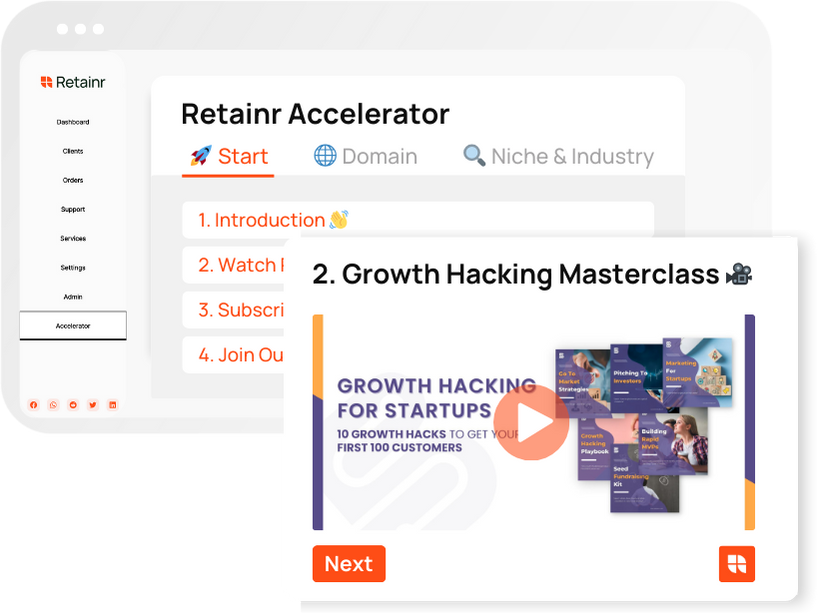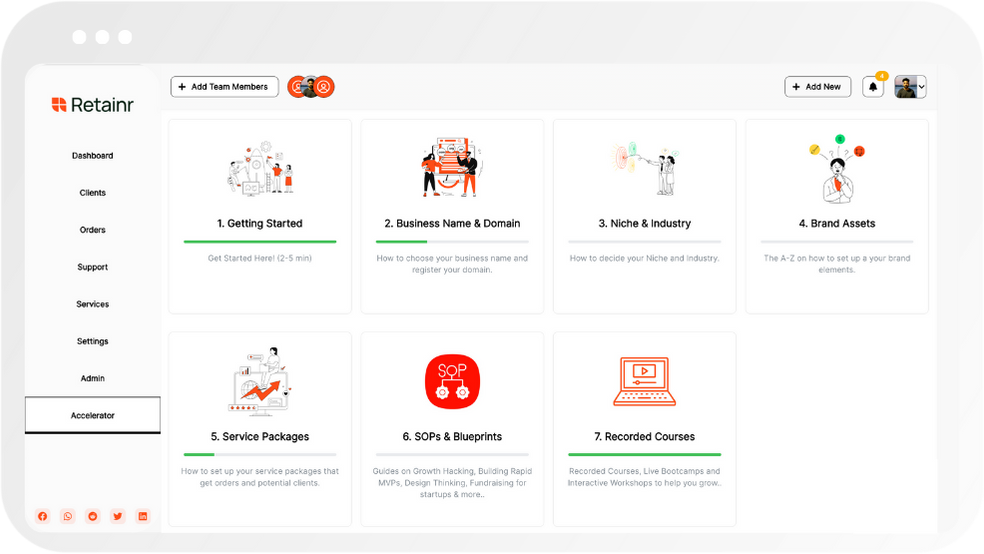
How To Create Impactful Presentation Slides
Build with Retainr
Sell your products and services, manage clients, orders, payments, automate your client onboarding and management with your own branded web application.
Get Started1. What are some effective techniques to create impactful presentation slides?
Key Techniques for Effective Presentation Slides
Firstly, effective visual design is instrumental in creating impactful presentation slides. This involves:
- Choosing clean, readable fonts
- Using high-contrast color schemes
- Minimizing clutter and prioritizing negative space
- Utilizing relevant, high-quality images or graphics
Secondly, the content of the slides should be audience-focused and utilize powerful storytelling techniques. This can be achieved by:
- Identifying the purpose and audience for each slide
- Crafting a compelling narrative throughout the presentation
- Using powerful but simple language
- Including call-to-actions when necessary
Comparison of Effective and Ineffective Slide Techniques
Making direct comparisons between effective and ineffective techniques is a good way to visually represent what works and what doesn't. The following table summarizes some comparisons.
| Effective Techniques | Ineffective Techniques |
|---|---|
| Clear and readable fonts | Complex or illegible fonts |
| High-contrast color schemes | Poor or low contrast colors |
| Minimalistic designs & high-quality images | Cluttered slides & pixelated images |
| Audience-focused & engaging storytelling | Presenter-focused & unengaging narrative |
2. How can I make my presentation slides more engaging and interactive?
Making Presentation Slides Engaging
Engaging presentation slides keep the audience attentive, interested, and aid understanding. Here are some ways to make your slides more engaging:
- Use of High-quality Graphics: High-quality images, diagrams, and infographics can make your points clearer and more concise.
- Include Surprises: You could add a shocking statistic, unexpected graphics, or bold statements that stir curiosity and keep the audiences' attention.
- Minimal Text: Slides should not be pages of an essay. Limit each slide to a single idea expressed concisely.
- Add Humor: It makes the presentation more enjoyable and memorable.
Promoting Interactivity in Slides
Interactive slides stimulate active engagement, promote better comprehension, and can get instant feedback. Tips to make slides interactive include:
- Live Polls: Services like Poll Everywhere can be embedded in slides to run real-time polls, quizzes, or Q and As.
- Interactive Infographics: These are graphics where users can interact to get more detailed information.
- Zoom or Scroll Effects: These can enhance animation, make navigation smoother, and make the presentation less linear.
- Video Clips: Short and relevant video clips can enliven your presentation and serve as good discussion starters.
Examples of Slide Designs
The following table highlights interactive and engaging elements you could incorporate into your slides with examples:
| Elements | Examples |
|---|---|
| Add Surprises | You could pose a controversial or thought-provoking question that challenges popular theories in your field. |
| Minimal Text | You could use a slide with just a powerful statement and an evocative image that tells the story. |
| Video Clips | You could embed a Ted Talk clip relevant to your topic that brings in an expert's perspective. |
| Live Polls | You could launch a live poll asking the audience to rate their familiarity with the topic of discussion. |
3. What elements should I include in my presentation slides to make them effective?
Key Elements for Effective Presentation Slides
Creating impactful presentation slides requires the effective use of several keying elements. First of all, simplicity should be your guiding principle. Viewers should be able to understand each slide in around three seconds. Use keywords and important phrases rather than complete sentences. Second, focus on visuals rather than text. Pictures, charts and diagrams are much more engaging and easier to remember than blocks of text. Third, ensure the consistency across your slides both in terms of aesthetics and content.
Maximising the Use of Text
In cases where textual content cannot be avoided, the use of bullet points can help in itemizing information which can lead to easy digestion of information. For example:
- Keep it concise
- Use bullet points, not sentences
- Use legible font sizes and types
Ensure your points are informative and provide meaningful insight. They should effectively summarize or complement the oral part of your presentation.
Utilising Visual Elements
The use of visuals can dramatically increase the engagement and effectiveness of your presentation. Visuals can come in different forms:
| Visuals | Usage |
|---|---|
| Images | Adds interest, explain difficult concepts |
| Charts | Represents numbers and trends |
| Videos | Demonstration, engagement |
Be sure to use high quality and relevant visuals. Use charts to represent data, images to support concepts, and videos to demonstrate or engage. Remember, your visuals should contribute to your message, not distract from it.
4. What type of visuals should I use to create impactful presentation slides?
Choosing the Right Visuals for Your Presentation Slides
The type of visuals you choose for your presentation can greatly influence its impact. Three main types of visuals that are often used in presentations include charts/graphs, images/photos, and infographics. These visuals help to make complex data more understandable, add interest and break up text, and convey complex information quickly and clearly.
Charts and Graphs
Charts and graphs are ideal for presenting numerical data. They can be used to highlight trends, compare data, or show relationships. The type of chart or graph you use will depend on the nature of your data. Some examples include:
| Chart Type | When to Use |
|---|---|
| Bar Chart | When comparing quantities or frequencies across different categories. |
| Pie Chart | When showing how individual parts make up a whole. |
| Line Graph | When showing trends over time. |
Images and Infographics
Images and infographics can serve a variety of purposes in your presentation. Images can add interest, provide visual examples, or serve as metaphoric representations of concepts. Infographics, on the other hand, are ideal when you need to present complicated information or data in a simplified, easy-to-understand way. Some tips for using images and infographics include:
- Use high-quality images: Pixelated or low-quality images can detract from your presentation’s overall look and credibility.
- Keep it relevant: Any visual you include should directly support the point being made. Irrelevant images can confuse your audience.
- Use infographic tools: There are many online tools available that make it easy to create your own customized infographics, such as Canva or Piktochart.
5. How much text should I use in each slide to effectively deliver my message?
Right Amount of Text for Effective Slide
The right amount of text on a slide can significantly aid your presentation rather than overwhelm your audience. It is usually advised to follow the 5/5/5 rule, which implies that a slide should have just 5 lines, each with no more than 5 words. This rule helps you maintain clarity and succinctness in your presentation, avoiding long and distracting sentences. Remember, the slide is there to supplement your talk, not to replace it.
Why Less Text is More Effective
You might wonder why less text often proves more effective. The reason behind this is our brain's processing capabilities. Studies show that when people listen and read simultaneously, they are unlikely to do both effectively. Hence, if your slide is text-heavy, your audience might focus more on understanding the slide rather than listening to you. Therefore, avoid paragraph style information and consider the Bullet-Point Approach.
- Singular Idea: Each point should represent just one idea.
- Concise: Be as brief and to-the-point as possible.
- Easy to read: Use a readable font size to ensure legibility, even from the back of the room.
Using Tables Effectively
If you need to present numerical data or a set of information organized logically, tables are highly efficient. Be sure to limit the amount of data on the table so the audience can quickly absorb it. Make sure each row and column is labeled precisely, and any complex data is simplified.
| Pros | Cons |
|---|---|
| Organized presentation of data | Overwhelming if too much data is presented |
| Easy comparison of data | Distracting if not designed correctly |
6. How can I ensure my presentation slides are easy to understand and follow?
Use Simple Language and Clarity
For your presentation slides to be easy to understand, it's important to use simple language and short sentences. Avoid using jargon and complex expressions, and always explain any acronyms or abbreviations you choose to use. Limit each slide to one key idea, and break down complex ideas into simpler, digestible bits. Include definitions if a term or concept may be unfamiliar to your audience.
Make use of bullet points to present your information in an orderly and digestible way. Here's an example:
- Limit each slide to one key idea.
- Explain acronyms and abbreviations.
- Use short sentences and simple language.
- Break down complex ideas into simpler bits.
- Include definitions for unfamiliar terms.
Visual Aids and Design Consistency
Use visual aids to support your key points. Diagrams, graphs, images and flowcharts can help to explain ideas in a way that words can't. When using graphics, ensure they are high quality and easy to read from a distance. Also be consistent with your slide design. Stick to a theme with consistent colours, fonts and layouts. This makes your presentation look professional and aids understanding as your audience won't be distracted by changes in formatting.
Here's an example of how to design your slides:
| Colors | Stick to a color scheme of 2-3 colors. |
|---|---|
| Fonts | Use legible fonts and keep the font size large. |
| Images | Use high quality images that are relevant to your content. |
| Layout | Keep the slide layout consistent throughout the presentation. |
Utilize Transition Slides and Signposting
Last, but not least, is the concept of 'signposting'. Signposting is like a roadmap for your presentation. It guides your audience through your presentation- outlining what has been covered and what is still to come. One way of doing this is by using transition slides at various points throughout your presentation. These slides can summarise key points from previous slides and introduce the next subject.
If effectively utilized, your audience should have no problem understanding and following your presentation. Remember, the key to a successful presentation lies in its ability to deliver its intended message clearly and concisely.
7. What are some common mistakes to avoid when creating presentation slides?
Common Mistakes in Creating Presentation Slides
Even with the best intentions and efforts, there are several common mistakes to avoid when creating presentation slides. These could easily affect the effectiveness and impact of your presentation. Let's delve into the most typical slip-ups:
- Too much text: Nothing puts audiences to sleep faster than slides filled wall-to-wall with text. Avoid this by using bullet points and condensing your information.
- Poor color choices: Colors should boost your presentation, not detract from it. Stick to easy-to-read color combinations.
- Overcomplicated visuals: Charts and graphs should aid comprehension rather than leaving viewers scratching their heads. Ensure your visual aids are clear and simple.
- Excessive animations or transitions: A few tastefully used animations can be impactful, but too many are distracting. Use sparingly.
- Ignoring font sizes and types: Small, hard-to-read fonts and overly stylish but unreadable font types can frustrate your audience. Prioritize readability.
There are many mistakes to sidestep when creating slides. By understanding the most common pitfalls, you can enhance your presentation and avoid those problematic issues. Here's a table summary:
| Common Mistakes | How to Avoid |
|---|---|
| Excessive text | Use bullet points and condensed text |
| Poor color combination | Choose easy-to-read color combinations |
| Complicated visuals | Ensure visual aids are clear and simple |
| Overuse of animations / transitions | Use animations sparingly |
| Unsuitable font sizes and types | Ensure font size and type are readable |
8. What tools or software can I use to create impactful presentation slides?
Utilizing Software For Impactful Presentions
There are several software tools available that can assist you in creating impactful slides. The software ranges in capabilities, some being ideal for simple presentations while others boasting advanced features for more intricate designs. Common presentation software includes PowerPoint, Keynote, and Google Slides. More design-focused software include Canva, Prezi, and Slidebean. Each tool carries its own unique features and benefits that make it suitable for specific presentation needs.
Despite the variety, all tools are equipped with several basic features that aid in the creation of dynamic and engaging each tool carries its own unique features and benefits that make it suitable for specific presentation needs.Charting The Features Of Presentation Tools
| Tool | Basic Features | Advanced Features |
|---|---|---|
| PowerPoint | Slide templates, Text editing, Image insertion | 3D models, Morph transition, Zoom for PowerPoint |
| Keynote | Slide templates, Text editing, Image insertion | Magic Move transition, Collaboration Tools, Apple Pencil compatibility |
| Google Slides | Slide templates, Text editing, Image insertion | Collaboration Tools, Auto save feature, Google Workspace integration |
Online Tools For Engaging Presentations
The growing trend towards remote work has led to the rise of web-based presentation tools. These allow the user to create and share presentations directly online, without the need for software installation. Tools such as Canva provide an array of template designs, fonts, shapes, and images that can be easily dragged and dropped onto your slide, perfect for those who may not have strong design skills. Prezi, on the other hand, offers an non-linear presentation style with zooming user interface, making your slide transitions look seamless and visually engaging. When it comes to data presentation, Slidebean stands out with AI that auto arranges your content for a clean, professional look.
9. How can I utilize colors and fonts effectively in my slides?
Utilizing Colors Effectively
Colors play a major role in making your presentation visually appealing and concise. Here are some key points to remember when incorporating colors:
- Consistency: Stick to a consistent color palette throughout your slides. It helps in creating a cohesive image.
- Contrast: This can draw attention to important points and makes text readable. Use colors that have high contrast with each other for instance, black text on a white background.
- Psychology of Colors: Different colors evoke different emotions. For example, red often signifies urgency while blue represents calmness. .
Utilizing Fonts Effectively
The right choice of fonts can greatly enhance the readability and aesthetics of your slides. Consider the following tips while choosing fonts:
- Readability: Always choose a font size that is easy to read, even from a distance.
- Texture: Utilize different font types, bold, italics, or underline to emphasize and distinguish between different types of information.
- Consistency: Just like with colors, consistency is crucial. Stick to maximum of three types of fonts in your presentation.
Example of Color and Font Use
| Slide Element | Color / Font Style | Reason |
|---|---|---|
| Main Title | Big, Bold, Black font | Attracts attention and conveys the main topic clearly. |
| Sub Titles | Dark Blue, Bold Font | Visually separates each section of content. |
| Body Text | Black, Normal Font | Easy to read and contrasts with background |
| Highlights / Important Points | Red, Italicized font | Draws attention to crucial points |
10. How important is the design consistency throughout the presentation slides? Should all slides look similar?
The Importance of Design Consistency in Presentation Slides
Design consistency plays a pivotal role in creating impactful presentation slides. It helps in maintaining the professional look and feel throughout the presentation. Consistent design elements, typography, colors, and layout help the viewer to focus on the core content rather than getting distracted by diverse design aesthetics on different slides. Similarly, a well-coordinated and structured slideshow helps to reinforce your message and makes it easier for the audience to follow your narrative.
- Reduces cognitive load: A consistent design reduces the cognitive load on the viewers because their brain does not have to adjust to new design aesthetics with each slide change. This allows them to focus on the content instead of struggling with the design.
- Reinforces branding: If you are presenting on behalf of a business or organization, maintaining design consistency with the organization’s color scheme and typography can reinforce branding.
- Improves comprehensibility: A uniform design approach ensures that viewers can understand the slide content quickly and easily. A varied design can cause confusion and hinder understanding.
Should All Slides Look Similar?
While it is important that slides have design consistency, it doesn’t mean that all slides should look exactly similar. There should be a design difference between the different types of slides in any presentation. For example, your topic slide, content slide, and conclusion slide can have variations so that they stand out. However, these variations should still align with the overall design consistency of the presentation. The balance between similarity and difference is important to keep the presentation engaging, but not monotonous.
| Slide Type | Design Approach |
|---|---|
| Topic Slide | Eye-catching, distinct but still aligns with the overall design theme. |
| Content Slide | More reserved design, focus on readability and alignment with the overall design consistency. |
| Conclusion Slide | Can be slightly more dramatic to re-emphasize the message and signal the end of the presentation, while still maintaining the overall design consistency. |
Conclusion
Creating Impactful Presentation Slides
Presentations are essential in various field- from academia to corporate sectors. Creating impactful presentation slides can make or break your opportunity to influence, educate or persuade the audience. They can help you visually pass information, key takeaways, and insights.
To create impactful presentation slides, start by understanding your audience. Tailor your presentation to fit their needs and capture their attention. Ensure the content is clear, concise, and relevant. Make use of bullet points, charts, and images. Use large, readable fonts and avoid using excessive text on a slide. Also, ensure your presentation has a consistent design and flow from one slide to another.
Empower Your Presentation Creation with Retainr.io
Enhancing your presentation creation process is possible with the right kind of software like Retainr.io. It is more than just a whitelabel software that helps you manage your clients, orders and charges. It can also be a game-changer when it comes to creating outstanding slide presentations.
With Retainr.io, you can create engaging, visually striking slides that will leave your audience impressed and engaged. It not only enables you to effectively communicate your key points but also helps in maintaining your brand consistency throughout the presentation.
Creating professional presentations has never been easier with Retainr.io. With functionalities aimed at enhancing your presentation and sales, it is an undeniable utility for any professional or business.
Upgrade your presentation creation process today with Retainr.io and make an impact every time you step up to present!
Boost Your Agency Growth
with Retainr Accelerator
Uncover secrets, strategies, and exclusive blueprints to take your agency's growth to the next level — from marketing insights to effective presentations and leveraging technology.

SOPs, Cheatsheets & Blueprints
Leverage 50+ SOPs (valued over $10K) offering practical guides, scripts, tools, hacks, templates, and cheat sheets to fast-track your startup's growth.
Connect with fellow entrepreneurs, share experiences, and get expert insights within our exclusive Facebook community.
.jpg)

Join a thriving community of growth hackers. Network, collaborate, and learn from like-minded entrepreneurs on a lifelong journey to success.

Gain expertise with recorded Courses, Live Bootcamps and interactive Workshops on topics like growth hacking, copywriting, no-code funnel building, performance marketing and more, taught by seasoned coaches & industry experts.

.jpg)

.jpeg)


